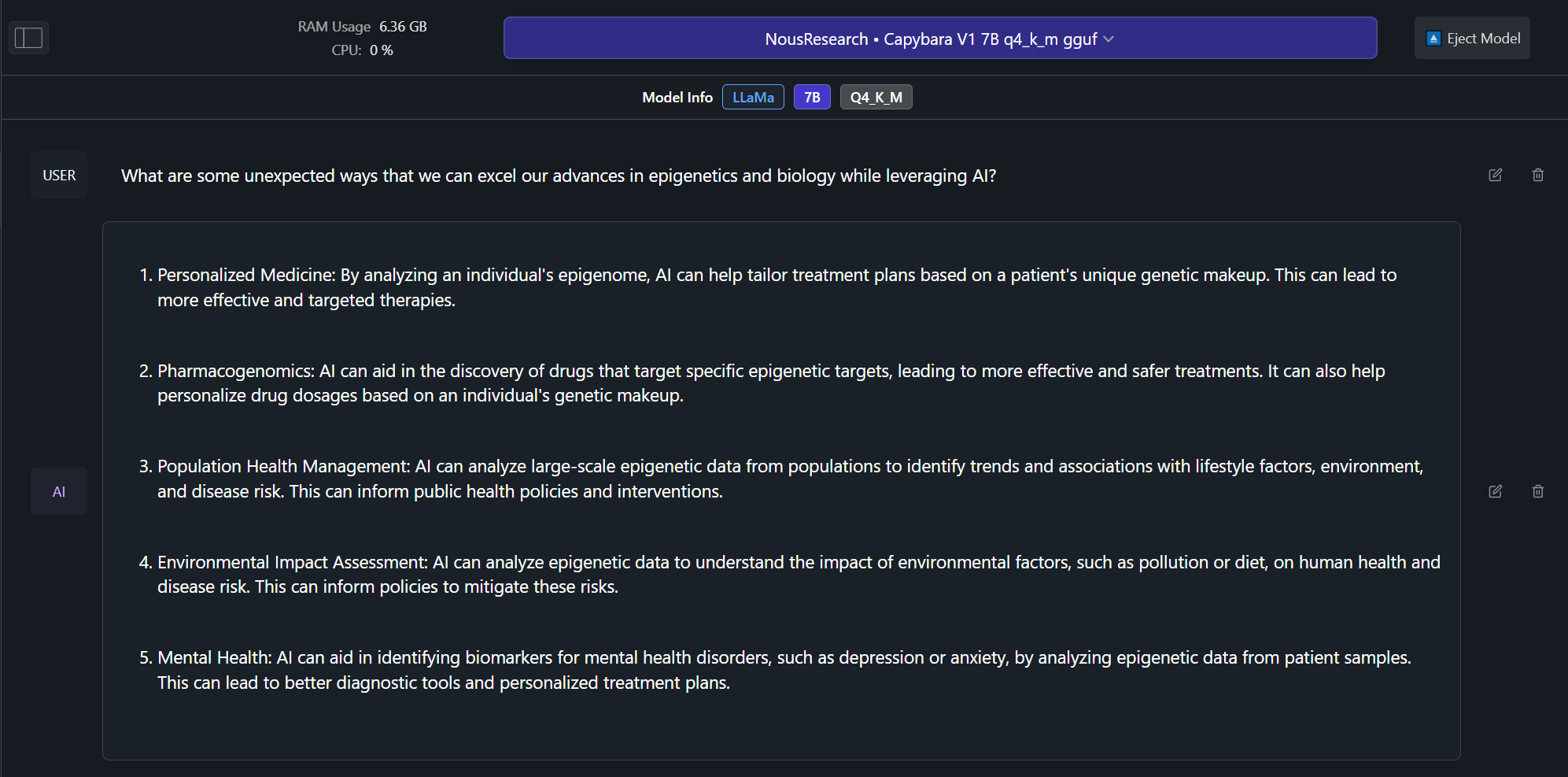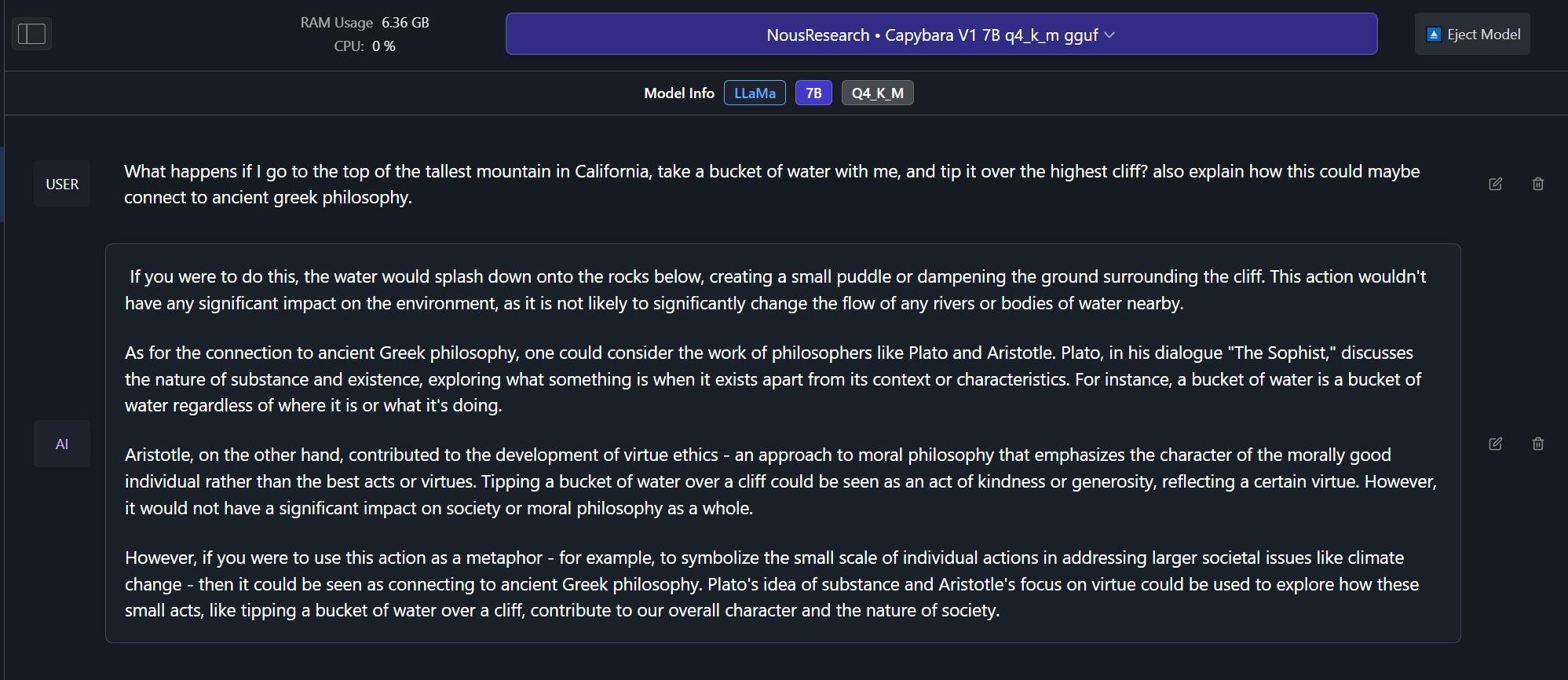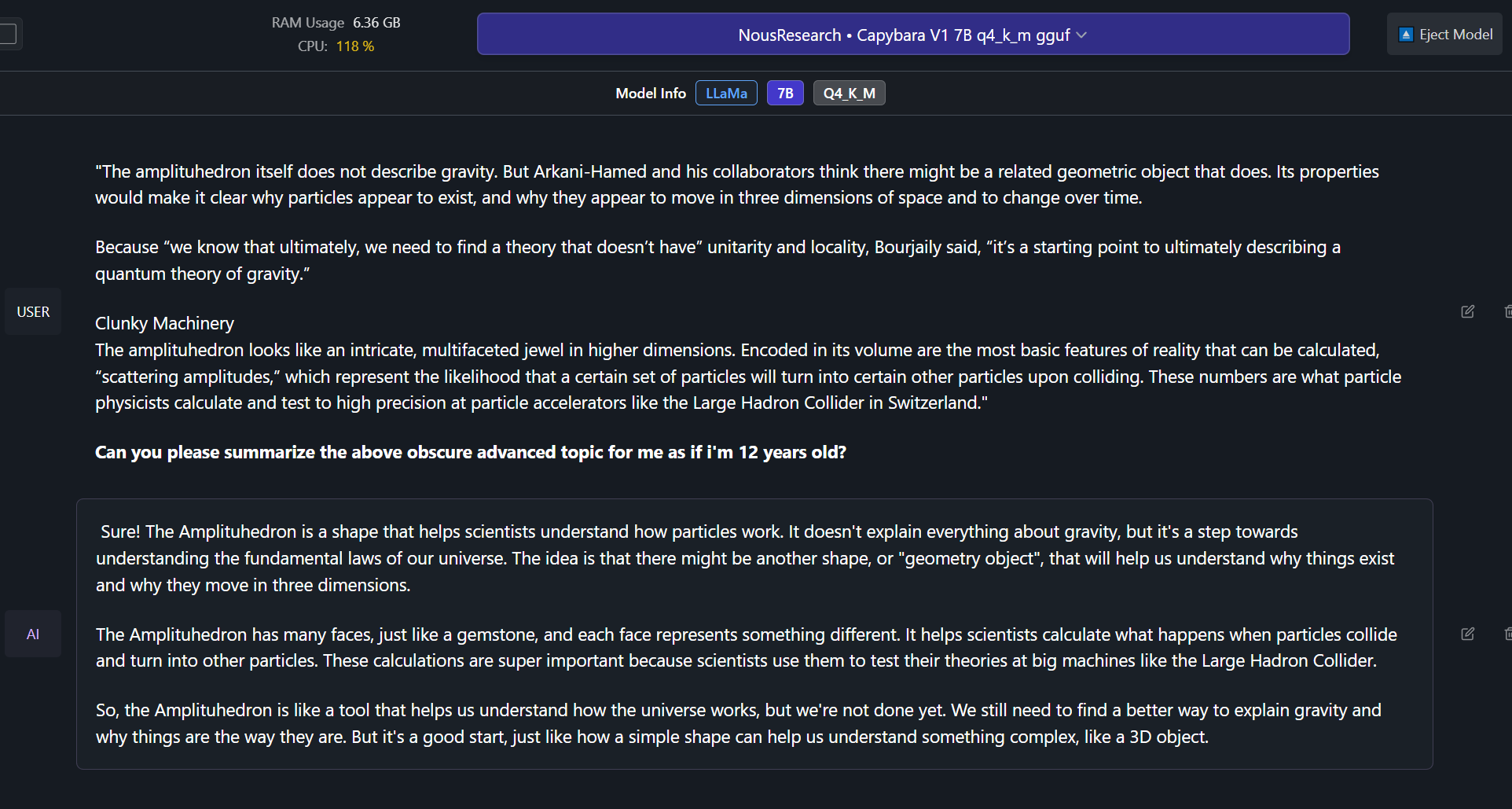
TheBloke's LLM work is generously supported by a grant from andreessen horowitz (a16z)
Nous Capybara 34B - GPTQ
- Model creator: NousResearch
- Original model: Nous Capybara 34B
Description
This repo contains GPTQ model files for NousResearch's Nous Capybara 34B.
Multiple GPTQ parameter permutations are provided; see Provided Files below for details of the options provided, their parameters, and the software used to create them.
These files were quantised using hardware kindly provided by Massed Compute.
Repositories available
- AWQ model(s) for GPU inference.
- GPTQ models for GPU inference, with multiple quantisation parameter options.
- 2, 3, 4, 5, 6 and 8-bit GGUF models for CPU+GPU inference
- NousResearch's original unquantised fp16 model in pytorch format, for GPU inference and for further conversions
Prompt template: User-Assistant
USER: {prompt} ASSISTANT:
Known compatible clients / servers
These GPTQ models are known to work in the following inference servers/webuis.
This may not be a complete list; if you know of others, please let me know!
Provided files, and GPTQ parameters
Multiple quantisation parameters are provided, to allow you to choose the best one for your hardware and requirements.
Each separate quant is in a different branch. See below for instructions on fetching from different branches.
Most GPTQ files are made with AutoGPTQ. Mistral models are currently made with Transformers.
Explanation of GPTQ parameters
- Bits: The bit size of the quantised model.
- GS: GPTQ group size. Higher numbers use less VRAM, but have lower quantisation accuracy. "None" is the lowest possible value.
- Act Order: True or False. Also known as
desc_act. True results in better quantisation accuracy. Some GPTQ clients have had issues with models that use Act Order plus Group Size, but this is generally resolved now. - Damp %: A GPTQ parameter that affects how samples are processed for quantisation. 0.01 is default, but 0.1 results in slightly better accuracy.
- GPTQ dataset: The calibration dataset used during quantisation. Using a dataset more appropriate to the model's training can improve quantisation accuracy. Note that the GPTQ calibration dataset is not the same as the dataset used to train the model - please refer to the original model repo for details of the training dataset(s).
- Sequence Length: The length of the dataset sequences used for quantisation. Ideally this is the same as the model sequence length. For some very long sequence models (16+K), a lower sequence length may have to be used. Note that a lower sequence length does not limit the sequence length of the quantised model. It only impacts the quantisation accuracy on longer inference sequences.
- ExLlama Compatibility: Whether this file can be loaded with ExLlama, which currently only supports Llama and Mistral models in 4-bit.
| Branch | Bits | GS | Act Order | Damp % | GPTQ Dataset | Seq Len | Size | ExLlama | Desc |
|---|---|---|---|---|---|---|---|---|---|
| main | 4 | None | Yes | 0.1 | wikitext | 8192 | 18.60 GB | Yes | 4-bit, with Act Order. No group size, to lower VRAM requirements. |
| gptq-4bit-128g-actorder_True | 4 | 128 | Yes | 0.1 | wikitext | 8192 | 19.25 GB | Yes | 4-bit, with Act Order and group size 128g. Uses even less VRAM than 64g, but with slightly lower accuracy. |
| gptq-4bit-32g-actorder_True | 4 | 32 | Yes | 0.1 | wikitext | 8192 | 21.21 GB | Yes | 4-bit, with Act Order and group size 32g. Gives highest possible inference quality, with maximum VRAM usage. |
| gptq-3bit-128g-actorder_True | 3 | 128 | Yes | 0.1 | wikitext | 8192 | 15.03 GB | No | 3-bit, with group size 128g and act-order. Higher quality than 128g-False. |
| gptq-8bit--1g-actorder_True | 8 | None | Yes | 0.1 | wikitext | 8192 | 35.34 GB | No | 8-bit, with Act Order. No group size, to lower VRAM requirements. |
| gptq-3bit-32g-actorder_True | 3 | 32 | Yes | 0.1 | wikitext | 8192 | 16.90 GB | No | 3-bit, with group size 64g and act-order. Highest quality 3-bit option. |
| gptq-8bit-128g-actorder_True | 8 | 128 | Yes | 0.1 | wikitext | 8192 | 36.11 GB | No | 8-bit, with group size 128g for higher inference quality and with Act Order for even higher accuracy. |
How to download, including from branches
In text-generation-webui
To download from the main branch, enter TheBloke/Nous-Capybara-34B-GPTQ in the "Download model" box.
To download from another branch, add :branchname to the end of the download name, eg TheBloke/Nous-Capybara-34B-GPTQ:gptq-4bit-128g-actorder_True
From the command line
I recommend using the huggingface-hub Python library:
pip3 install huggingface-hub
To download the main branch to a folder called Nous-Capybara-34B-GPTQ:
mkdir Nous-Capybara-34B-GPTQ
huggingface-cli download TheBloke/Nous-Capybara-34B-GPTQ --local-dir Nous-Capybara-34B-GPTQ --local-dir-use-symlinks False
To download from a different branch, add the --revision parameter:
mkdir Nous-Capybara-34B-GPTQ
huggingface-cli download TheBloke/Nous-Capybara-34B-GPTQ --revision gptq-4bit-128g-actorder_True --local-dir Nous-Capybara-34B-GPTQ --local-dir-use-symlinks False
More advanced huggingface-cli download usage
If you remove the --local-dir-use-symlinks False parameter, the files will instead be stored in the central Hugging Face cache directory (default location on Linux is: ~/.cache/huggingface), and symlinks will be added to the specified --local-dir, pointing to their real location in the cache. This allows for interrupted downloads to be resumed, and allows you to quickly clone the repo to multiple places on disk without triggering a download again. The downside, and the reason why I don't list that as the default option, is that the files are then hidden away in a cache folder and it's harder to know where your disk space is being used, and to clear it up if/when you want to remove a download model.
The cache location can be changed with the HF_HOME environment variable, and/or the --cache-dir parameter to huggingface-cli.
For more documentation on downloading with huggingface-cli, please see: HF -> Hub Python Library -> Download files -> Download from the CLI.
To accelerate downloads on fast connections (1Gbit/s or higher), install hf_transfer:
pip3 install hf_transfer
And set environment variable HF_HUB_ENABLE_HF_TRANSFER to 1:
mkdir Nous-Capybara-34B-GPTQ
HF_HUB_ENABLE_HF_TRANSFER=1 huggingface-cli download TheBloke/Nous-Capybara-34B-GPTQ --local-dir Nous-Capybara-34B-GPTQ --local-dir-use-symlinks False
Windows Command Line users: You can set the environment variable by running set HF_HUB_ENABLE_HF_TRANSFER=1 before the download command.
With git (not recommended)
To clone a specific branch with git, use a command like this:
git clone --single-branch --branch gptq-4bit-128g-actorder_True https://huggingface.co/TheBloke/Nous-Capybara-34B-GPTQ
Note that using Git with HF repos is strongly discouraged. It will be much slower than using huggingface-hub, and will use twice as much disk space as it has to store the model files twice (it stores every byte both in the intended target folder, and again in the .git folder as a blob.)
How to easily download and use this model in text-generation-webui
Please make sure you're using the latest version of text-generation-webui.
It is strongly recommended to use the text-generation-webui one-click-installers unless you're sure you know how to make a manual install.
Click the Model tab.
Under Download custom model or LoRA, enter
TheBloke/Nous-Capybara-34B-GPTQ.- To download from a specific branch, enter for example
TheBloke/Nous-Capybara-34B-GPTQ:gptq-4bit-128g-actorder_True - see Provided Files above for the list of branches for each option.
- To download from a specific branch, enter for example
Click Download.
The model will start downloading. Once it's finished it will say "Done".
In the top left, click the refresh icon next to Model.
In the Model dropdown, choose the model you just downloaded:
Nous-Capybara-34B-GPTQThe model will automatically load, and is now ready for use!
If you want any custom settings, set them and then click Save settings for this model followed by Reload the Model in the top right.
- Note that you do not need to and should not set manual GPTQ parameters any more. These are set automatically from the file
quantize_config.json.
- Note that you do not need to and should not set manual GPTQ parameters any more. These are set automatically from the file
Once you're ready, click the Text Generation tab and enter a prompt to get started!
Serving this model from Text Generation Inference (TGI)
It's recommended to use TGI version 1.1.0 or later. The official Docker container is: ghcr.io/huggingface/text-generation-inference:1.1.0
Example Docker parameters:
--model-id TheBloke/Nous-Capybara-34B-GPTQ --port 3000 --quantize gptq --max-input-length 3696 --max-total-tokens 4096 --max-batch-prefill-tokens 4096
Example Python code for interfacing with TGI (requires huggingface-hub 0.17.0 or later):
pip3 install huggingface-hub
from huggingface_hub import InferenceClient
endpoint_url = "https://your-endpoint-url-here"
prompt = "Tell me about AI"
prompt_template=f'''USER: {prompt}
ASSISTANT:
'''
client = InferenceClient(endpoint_url)
response = client.text_generation(prompt,
max_new_tokens=128,
do_sample=True,
temperature=0.7,
top_p=0.95,
top_k=40,
repetition_penalty=1.1)
print(f"Model output: {response}")
Python code example: inference from this GPTQ model
Install the necessary packages
Requires: Transformers 4.33.0 or later, Optimum 1.12.0 or later, and AutoGPTQ 0.4.2 or later.
pip3 install --upgrade transformers optimum
# If using PyTorch 2.1 + CUDA 12.x:
pip3 install --upgrade auto-gptq
# or, if using PyTorch 2.1 + CUDA 11.x:
pip3 install --upgrade auto-gptq --extra-index-url https://huggingface.github.io/autogptq-index/whl/cu118/
If you are using PyTorch 2.0, you will need to install AutoGPTQ from source. Likewise if you have problems with the pre-built wheels, you should try building from source:
pip3 uninstall -y auto-gptq
git clone https://github.com/PanQiWei/AutoGPTQ
cd AutoGPTQ
git checkout v0.5.1
pip3 install .
Example Python code
from transformers import AutoModelForCausalLM, AutoTokenizer, pipeline
model_name_or_path = "TheBloke/Nous-Capybara-34B-GPTQ"
# To use a different branch, change revision
# For example: revision="gptq-4bit-128g-actorder_True"
model = AutoModelForCausalLM.from_pretrained(model_name_or_path,
device_map="auto",
trust_remote_code=True,
revision="main")
tokenizer = AutoTokenizer.from_pretrained(model_name_or_path, use_fast=True)
prompt = "Tell me about AI"
prompt_template=f'''USER: {prompt}
ASSISTANT:
'''
print("\n\n*** Generate:")
input_ids = tokenizer(prompt_template, return_tensors='pt').input_ids.cuda()
output = model.generate(inputs=input_ids, temperature=0.7, do_sample=True, top_p=0.95, top_k=40, max_new_tokens=512)
print(tokenizer.decode(output[0]))
# Inference can also be done using transformers' pipeline
print("*** Pipeline:")
pipe = pipeline(
"text-generation",
model=model,
tokenizer=tokenizer,
max_new_tokens=512,
do_sample=True,
temperature=0.7,
top_p=0.95,
top_k=40,
repetition_penalty=1.1
)
print(pipe(prompt_template)[0]['generated_text'])
Compatibility
The files provided are tested to work with Transformers. For non-Mistral models, AutoGPTQ can also be used directly.
ExLlama is compatible with Llama and Mistral models in 4-bit. Please see the Provided Files table above for per-file compatibility.
For a list of clients/servers, please see "Known compatible clients / servers", above.
Discord
For further support, and discussions on these models and AI in general, join us at:
Thanks, and how to contribute
Thanks to the chirper.ai team!
Thanks to Clay from gpus.llm-utils.org!
I've had a lot of people ask if they can contribute. I enjoy providing models and helping people, and would love to be able to spend even more time doing it, as well as expanding into new projects like fine tuning/training.
If you're able and willing to contribute it will be most gratefully received and will help me to keep providing more models, and to start work on new AI projects.
Donaters will get priority support on any and all AI/LLM/model questions and requests, access to a private Discord room, plus other benefits.
- Patreon: https://patreon.com/TheBlokeAI
- Ko-Fi: https://ko-fi.com/TheBlokeAI
Special thanks to: Aemon Algiz.
Patreon special mentions: Brandon Frisco, LangChain4j, Spiking Neurons AB, transmissions 11, Joseph William Delisle, Nitin Borwankar, Willem Michiel, Michael Dempsey, vamX, Jeffrey Morgan, zynix, jjj, Omer Bin Jawed, Sean Connelly, jinyuan sun, Jeromy Smith, Shadi, Pawan Osman, Chadd, Elijah Stavena, Illia Dulskyi, Sebastain Graf, Stephen Murray, terasurfer, Edmond Seymore, Celu Ramasamy, Mandus, Alex, biorpg, Ajan Kanaga, Clay Pascal, Raven Klaugh, 阿明, K, ya boyyy, usrbinkat, Alicia Loh, John Villwock, ReadyPlayerEmma, Chris Smitley, Cap'n Zoog, fincy, GodLy, S_X, sidney chen, Cory Kujawski, OG, Mano Prime, AzureBlack, Pieter, Kalila, Spencer Kim, Tom X Nguyen, Stanislav Ovsiannikov, Michael Levine, Andrey, Trailburnt, Vadim, Enrico Ros, Talal Aujan, Brandon Phillips, Jack West, Eugene Pentland, Michael Davis, Will Dee, webtim, Jonathan Leane, Alps Aficionado, Rooh Singh, Tiffany J. Kim, theTransient, Luke @flexchar, Elle, Caitlyn Gatomon, Ari Malik, subjectnull, Johann-Peter Hartmann, Trenton Dambrowitz, Imad Khwaja, Asp the Wyvern, Emad Mostaque, Rainer Wilmers, Alexandros Triantafyllidis, Nicholas, Pedro Madruga, SuperWojo, Harry Royden McLaughlin, James Bentley, Olakabola, David Ziegler, Ai Maven, Jeff Scroggin, Nikolai Manek, Deo Leter, Matthew Berman, Fen Risland, Ken Nordquist, Manuel Alberto Morcote, Luke Pendergrass, TL, Fred von Graf, Randy H, Dan Guido, NimbleBox.ai, Vitor Caleffi, Gabriel Tamborski, knownsqashed, Lone Striker, Erik Bjäreholt, John Detwiler, Leonard Tan, Iucharbius
Thank you to all my generous patrons and donaters!
And thank you again to a16z for their generous grant.
Original model card: NousResearch's Nous Capybara 34B
Nous-Capybara-34B V1.9
This is trained on the Yi-34B model with 200K context length, for 3 epochs on the Capybara dataset!
First 34B Nous model and first 200K context length Nous model!
The Capybara series is the first Nous collection of models made by fine-tuning mostly on data created by Nous in-house.
We leverage our novel data synthesis technique called Amplify-instruct (Paper coming soon), the seed distribution and synthesis method are comprised of a synergistic combination of top performing existing data synthesis techniques and distributions used for SOTA models such as Airoboros, Evol-Instruct(WizardLM), Orca, Vicuna, Know_Logic, Lamini, FLASK and others, all into one lean holistically formed methodology for the dataset and model. The seed instructions used for the start of synthesized conversations are largely based on highly datasets like Airoboros, Know logic, EverythingLM, GPTeacher and even entirely new seed instructions derived from posts on the website LessWrong, as well as being supplemented with certain in-house multi-turn datasets like Dove(A successor to Puffin).
While performing great in it's current state, the current dataset used for fine-tuning is entirely contained within 20K training examples, this is 10 times smaller than many similar performing current models, this is signficant when it comes to scaling implications for our next generation of models once we scale our novel syntheiss methods to significantly more examples.
Process of creation and special thank yous!
This model was fine-tuned by Nous Research as part of the Capybara/Amplify-Instruct project led by Luigi D.(LDJ) (Paper coming soon), as well as significant dataset formation contributions by J-Supha and general compute and experimentation management by Jeffrey Q. during ablations.
Special thank you to A16Z for sponsoring our training, as well as Yield Protocol for their support in financially sponsoring resources during the R&D of this project.
Thank you to those of you that have indirectly contributed!
While most of the tokens within Capybara are newly synthsized and part of datasets like Puffin/Dove, we would like to credit the single-turn datasets we leveraged as seeds that are used to generate the multi-turn data as part of the Amplify-Instruct synthesis.
The datasets shown in green below are datasets that we sampled from to curate seeds that are used during Amplify-Instruct synthesis for this project.
Datasets in Blue are in-house curations that previously existed prior to Capybara.
Prompt Format
The reccomended model usage is:
USER:
ASSISTANT:
Mutli-Modality!
- We currently have a Multi-modal model based on Capybara V1.9! https://huggingface.co/NousResearch/Obsidian-3B-V0.5 it is currently only available as a 3B sized model but larger versions coming!
Notable Features:
Uses Yi-34B model as the base which is trained for 200K context length!
Over 60% of the dataset is comprised of multi-turn conversations.(Most models are still only trained for single-turn conversations and no back and forths!)
Over 1,000 tokens average per conversation example! (Most models are trained on conversation data that is less than 300 tokens per example.)
Able to effectively do complex summaries of advanced topics and studies. (trained on hundreds of advanced difficult summary tasks developed in-house)
Ability to recall information upto late 2022 without internet.
Includes a portion of conversational data synthesized from less wrong posts, discussing very in-depth details and philosophies about the nature of reality, reasoning, rationality, self-improvement and related concepts.
Example Outputs from Capybara V1.9 7B version! (examples from 34B coming soon):
Benchmarks! (Coming soon!)
Future model sizes
Capybara V1.9 now currently has a 3B, 7B and 34B size, and we plan to eventually have a 13B and 70B version in the future, as well as a potential 1B version based on phi-1.5 or Tiny Llama.
How you can help!
In the near future we plan on leveraging the help of domain specific expert volunteers to eliminate any mathematically/verifiably incorrect answers from our training curations.
If you have at-least a bachelors in mathematics, physics, biology or chemistry and would like to volunteer even just 30 minutes of your expertise time, please contact LDJ on discord!
Dataset contamination.
We have checked the capybara dataset for contamination for several of the most popular datasets and can confirm that there is no contaminaton found.
We leveraged minhash to check for 100%, 99%, 98% and 97% similarity matches between our data and the questions and answers in benchmarks, we found no exact matches, nor did we find any matches down to the 97% similarity level.
The following are benchmarks we checked for contamination against our dataset:
HumanEval
AGIEval
TruthfulQA
MMLU
GPT4All
- Downloads last month
- 42
Model tree for TheBloke/Nous-Capybara-34B-GPTQ
Base model
NousResearch/Nous-Capybara-34B


